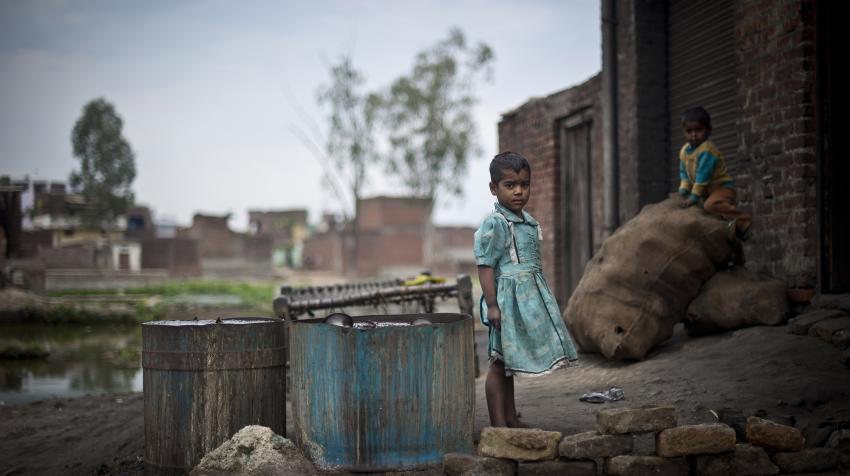Ending Poverty

The COVID-19 pandemic has caused an increase in the number of people living in extreme poverty, for the first time in a generation. Progress in important areas, such as childhood vaccination and income equality between countries has been reversed, which has not happened in the past three decades. If the current trend continues, it is projected that by 2030, a shocking 575 million people will still be living in extreme poverty, and 84 million children will not be able to attend school. It is estimated that it will take almost 300 years to eliminate discriminatory laws, end child marriage and close gender gaps in legal protection. In 2020, with 71 million more people living in extreme poverty than the year before, the COVID-19 crisis caused the biggest setback in global poverty reduction in decades.
In 2020, with 71 million more people living in extreme poverty than the year before, the COVID-19 crisis caused the biggest setback in global poverty reduction in decades. In April 2020, the United Nations issued a framework for the immediate socio-economic response to COVID-19 and created the Secretary-General’s UN COVID-19 Response and Recovery Fund.
From 1990 to 2014, the world made remarkable progress in reducing extreme poverty, with over one billion people moving out of that condition. The global poverty rate decreased by an average of 1.1 percentage points each year, from 37.8 percent to 11.2 percent in 2014. However, between 2014 and 2019, the pace of poverty reduction slowed to 0.6 percentage points per year, which is the slowest rate seen in the past three decades. Within the 24-year period, most of the poverty reduction was observed in East Asia and the Pacific, as well as South Asia.
What is Poverty?
Poverty entails more than the lack of income and productive resources to ensure sustainable livelihoods. Its manifestations include hunger and malnutrition, limited access to education and other basic services, social discrimination and exclusion, as well as the lack of participation in decision-making. In 2015, more than 736 million people lived below the international poverty line. Around 10 per cent of the world population (pre-pandemic) was living in extreme poverty and struggling to fulfil the most basic needs like health, education, and access to water and sanitation, to name a few. There were 122 women aged 25 to 34 living in poverty for every 100 men of the same age group, and more than 160 million children were at risk of continuing to live in extreme poverty by 2030.
Poverty facts and figures
- According to the most recent estimates, in 2023 almost 700 million people around the world were subsisting on less than $2.15.
- The share of the world’s workers living in extreme poverty fell by half over the last decade: from 14.3 per cent in 2010 to 7.1 per cent in 2019. However, in 2020 it rose for the first time in two decades after the COVID-19 pandemic.
- It is projected that the global goal of ending extreme poverty by 2030 will not be achieved, with almost 600 million people still living in extreme poverty.
- One out of six children lives in extreme poverty. Between 2013 and 2022, the number of children living on less than US$2.15 a day decreased from 383 million to 333 million, but the economic impact of COVID-19 led to three lost years of progress.
- In 2021, 53 per cent of the world’s population – 4.1 billion people – did not benefit from any form of social protection.
Poverty and the Sustainable Development Goals
Ending poverty in all its forms is the first of the 17 Sustainable Development Goals (SDGs) of the 2030 Agenda for Sustainable Development.
The SDGs’ main reference to combatting poverty is made in target 1.A: “Ensure significant mobilization of resources from a variety of sources, including through enhanced development cooperation, in order to provide adequate and predictable means for developing countries, in particular least developed countries, to implement programmes and policies to end poverty in all its dimensions.”
The SDGs also aim to create sound policy frameworks at national and regional levels, based on pro-poor and gender-sensitive development strategies to ensure that by 2030 all men and women have equal rights to economic resources, as well as access to basic services, ownership and control over land and other forms of property, inheritance, natural resources, appropriate new technology and financial services, including microfinance.
Measuring Poverty
There has been marked progress in reducing poverty over the past decades. In 2015, 10 per cent of the world’s population lived at or below $1.90 a day -down from 16 per cent in 2010 and 36 per cent in 1990- while in 2023 almost 700 million people around the world were subsisting on less than $2.15.
At current rates of progress, the world will likely not meet the global goal of ending extreme poverty by 2030, with estimates indicating that nearly 600 million people will still be struggling with extreme poverty then.
Extreme poverty is concentrated in places where it will be hardest to eradicate— among the least developed countries, in conflict-affected areas, and in remote, rural areas. The outlook is also grim for the nearly 50 percent of the world’s population who live on less than $6.85 a day – the measure used for upper-middle-income countries.
Global Action
The 2030 Agenda for Sustainable Development promises to leave no one behind and to reach those furthest behind first. Meeting this ambitious development agenda requires visionary policies for sustainable, inclusive, sustained and equitable economic growth, supported by full employment and decent work for all, social integration, declining inequality, rising productivity and a favorable environment. In the 2030 Agenda, Goal 1 recognizes that ending poverty in all its forms everywhere is the greatest global challenge facing the world today and an indispensable requirement for sustainable development.
While progress in eradicating extreme poverty has been incremental and widespread, the persistence of poverty, including extreme poverty remains a major concern in Africa, the least developed countries, small island developing States, in some middle-income countries, and countries in situations of conflict and post-conflict countries. In light of these concerns, the General Assembly, at its seventy-second session, decided to proclaim the Third United Nations Decade for the Eradication of Poverty (2018–2027). The objective of the Third Decade is to maintain the momentum generated by the implementation of the Second United Nations Decade for the Eradication of Poverty (2008-2017) towards poverty eradication. Further, the 3rd Decade is also expected to support, in an efficient and coordinated manner, the internationally agreed development goals related to poverty eradication, including the Sustainable Development Goals.
Department of Economic and Social Affairs (DESA)
In 1995, the World Summit for Social Development held in Copenhagen, identified three core issues: poverty eradication, employment generation and social integration, in contributing to the creation of an international community that enables the building of secure, just, free and harmonious societies offering opportunities and higher standards of living for all.
Within the United Nations system, the Division for Social Policy and Development (DSPD) of the Department of Economic and Social Affairs (DESA) acts as Focal Point for the United Nations Decade for the Eradication of Poverty and undertakes activities that assist and facilitate governments in more effective implementation of the commitments and policies adopted in the Copenhagen Declaration on Social Development and the further initiatives on Social Development adopted at the 24th Special session of the General Assembly.
A potential game-changer in accelerating SDG progress
At the 2023 SDG Summit held at the UN’s headquarters in New York, the General Assembly adopted a political declaration to accelerate action to achieve the 17 Sustainable Development Goals (SDG). The document aims to drive economic prosperity and well-being for all people while protecting the environment. In addition, it includes a commitment to financing for developing countries and supports the proposal of an SDG Stimulus of at least $500 billion annually, as well as an effective debt-relief mechanism.
International Day for the Eradication of Poverty
Through resolution 47/196 adopted on 22 December 1992, the General Assembly declared 17 October as the International Day for the Eradication of Poverty.
The observance of the International Day for the Eradication of Poverty can be traced back to 17 October 1987. On that day, over a hundred thousand people gathered at the Trocadéro in Paris, where the Universal Declaration of Human Rights was signed in 1948, to honour the victims of extreme poverty, violence and hunger. They proclaimed that poverty is a violation of human rights and affirmed the need to come together to ensure that these rights are respected. These convictions are inscribed on a commemorative stone unveiled that day. Since then, people of all backgrounds, beliefs and social origins have gathered every year on October 17th to renew their commitment and show their solidarity with the poor.

